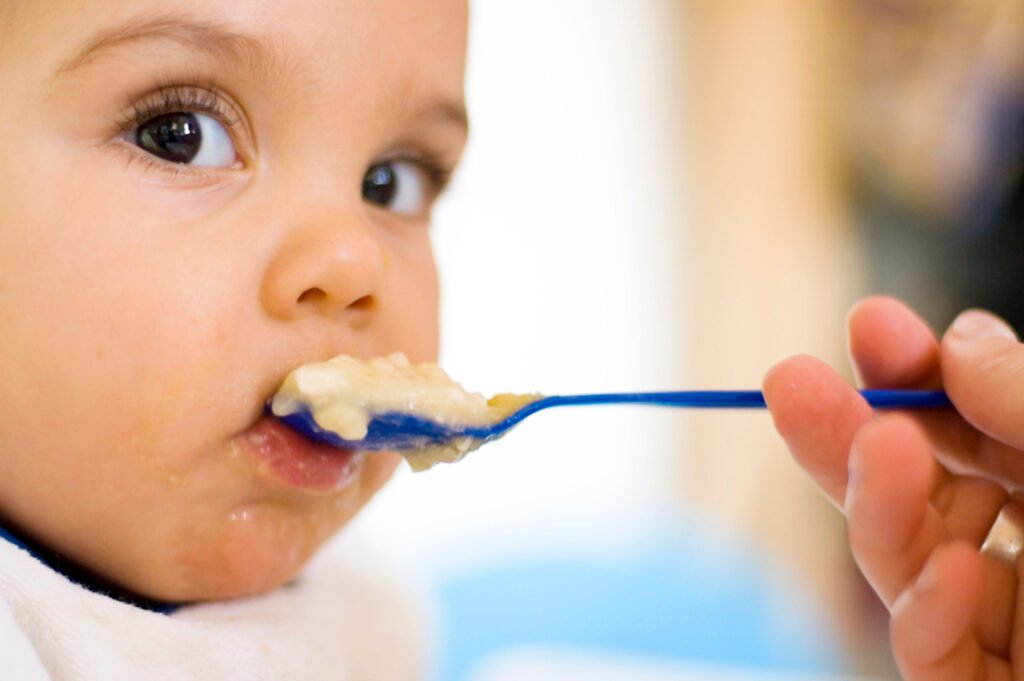What food is Better For Your Baby: Raw or Cooked?
Table of Contents
At what age can you give raw food?
What food is better for the Baby: Raw or Cooked? From the 4th month of life, you can give a baby a spoonful of raw apple, pear, or orange juice. You can gradually increase the amount of juice diluted with water until a bottle reaches 100 – 150 ml in the 6th month. From the 6th month onwards, you can give washed raw and peeled fruits such as apples, pears, and bananas together with a plant milk product as part of snacks.
After the first cooked food between the 5th and 8th months of life, the baby can eat raw vegetables such as carrot and cucumber around the 8th to 10th month. The finely grated raw vegetables help refine baby’s taste buds and diversify their diet. Make the vegetables more tender by soaking them in a little lemon juice or, for carrots, orange juice. From 6 months onwards, parsley or a few basil leaves mixed in with the soup are no longer dangerous.
The baby can now suck a small slice of apple or chew a banana piece by learning to chew. Fruits are the first food baby allowed to eat raw. The rest of the food has to be cooked, as the baby’s stomach cannot digest fibers such as those found in celery, artichoke, or beetroot.
Pros and cons for baby
The advantage of raw foods for babies is that they will consume all the vitamins they like while teething.
The benefit of cooked food is discovering new flavors and textures, sometimes tender and sometimes crispy.
How does cooking affect the taste and texture?
Rice and pasta, swell when they absorb cooking water. Cooking makes fruits and vegetables softer, smoother, and easier to digest. So think of compotes and creamy soups.
Cooking changes the natural colors of foods and makes them appear weaker. Plants will more or less fade depending on their pigments, acidity, and cooking method. Green vegetables turn yellow if you cook them too long or if they are covered. Pasta, baked goods, and foods that have been rolled in flour before cooking will change color due to the caramelized starch.
Depending on the type of cooking and under the influence of heat, specific food components accumulate in the middle. Flavors that you add to the food during cooking, aromatic addition like, stocks, salty or sweet liquids, envelop the food with a rich taste. Cooking vegetables with plant milk or broth makes them even tastier for babies.
Some vitamins and minerals are sensitive to heat; they suffer depending on the cooking time and temperature.
How to try raw?
Wash fruits and vegetables with clean water. A few drops of lemon juice reliably eliminate all traces of pesticides. Use aromatic plants such as parsley, basil, anise or onions, garlic, and shallots. They contain protective micronutrients (vitamins, minerals) and are rich in flavor.
Baby food raw or cooked
What types of cooking are the best?
Steaming: Steaming preserves the natural taste and most of the vitamins in the food.
In water: In the cooking water are vitamins and minerals. So keep it and use it for your preparations.
Grilling: you achieve with good vegetable oils, olive or peanut oil, crispy, somewhat firmer textures.
In the Pan: With oil or butter, this type of cooking gives vegetables and fruit a characteristic gourmet taste.
As a soup or stew: This type of cooking has the advantage of allowing food and spices to dissolve together over low heat. The texture becomes creamy, and the taste is less intense and strong, two aspects that young children appreciate.
Frying: Cooking in the oil gives it a crispy aspect and an oily texture. Most children love this, but once a week should be enough. Watch out for excessively roasted or burnt parts; they are toxic to babies.
Preserving: A gentle way of cooking that allows the baby to digest all types of fruit.
Raw food allows the original texture and taste of the food, and it preserves the nutrients. The different cooking methods offer advantages in terms of taste and make food more comfortable for babies to digest.

First complementary food – raw vegan from the start
The first complementary food plays an essential role in developing the digestive system and the baby’s supply of nutrients. This new and exciting phase can take place with confidence for parents and baby
When is the ideal time for the first complementary food?
It is most optimal to fully breastfeed the baby for at least six months, if possible. Breastfed babies have the optimal supply of valuable nutrients, and more extended breastfeeding periods are associated with a lower risk of chronic diseases and improved cognitive performance.
However, that does not mean that one should force a long period of breastfeeding. It is more important to feel with the baby when slowly adding in the complementary food is right.
As long as the baby is thriving and satisfied, you shouldn’t be disturbed. However, if they gradually show an increased interest in food, it is time for the first complimentary food. The baby will express itself acoustically, watch the family dinner with wide eyes, or imitate its older sibling.
If the baby already reaches eagerly for the meal, place soft pieces of vegetables or fruit in its hand. For example, a bit of pear, peeled cucumber, or melon is possible.
Can the baby be fed raw vegan from the start?
Many different opinions on this often lead to uncertainty among young parents. Natural foods are wonderfully suitable for the first additional feeding right from the start.
Fresh fruits, vegetables, nuts, and seeds are the most nutritious. They have a rich nutrient spectrum in their natural compound and contain no additives. They are not subject to nutrient loss by preserving and developing an innate sense of taste in the baby.
Remember that food in jars is always pasteurized for reasons of shelf life. Also, pay close attention to the list of ingredients! Baby jars can already contain artificial vitamins, starch, salt, ascorbic acid, and others.
How can the baby be supplied with healthy fats?
Healthy fats are essential, but vegetable oils are very concentrated foods. Peeled hemp seeds, for example, are more suitable. They have an excellent omega-3: omega-6 ratio, which is soft and comfortable to process in a pulp. Achieve an adequate supply of saturated fatty acids with a little coconut butter. Avocados have valuable monounsaturated fatty acids.
How can the iron requirement be met?
Vegetables also contain iron, especially leafy greens, and mild wild herbs. In combination with fruit that contains vitamin C, you can increase the bioavailability.
Organic food is the best choice for the preparation of baby food. Here the pollution is much lower than with conventionally grown fruit and vegetables.
First baby food recipes
Soft fruits and vegetables you can mash with a fork. Everything else can be pureed or mixed in a small blender. The temperature is comfortable if you heat the porridge to 40 degrees in a water bath.
Baby smoothie bowl
Recipe ideas: spinach, banana, apple, or spinach, avocado, mango also, chickweed, avocado, apple, or lamb’s lettuce, banana, orange, also, nettle, banana, pear.
It is advisable not to get the baby too used to sweets right from the start and better focus on vegetables, especially leafy greens.
Avocado Recipes
Recipe ideas: Mix Avocado with pear or with orange, or avocado with cucumber.

Colorful recipes
Banana, blueberries, 1/4 teaspoon coconut I avocado, orange I apple, 1/2 teaspoon hemp seeds and cinnamon I carrot, zucchini, 1/4 teaspoon coconut.
Other recipe ideas: carrots, tomatoes, coconut butter I fennel with hemp seeds I banana, avocado, cocoa
Delicious plant milk recipes
There are high-quality, plant-based alternatives to animal milk for the production of baby food.
Almond milk
Process 1 tbsp almond butter with 250 ml of water in a mixer to make milk.
Hemp milk
Puree 50 g peeled hemp seeds, 500 ml water, one date in a blender.
Buckwheat milk
Soak 50 g buckwheat overnight, puree with 500 ml water, and one date in the morning.
Soy milk
Soy milk is not suitable for feeding babies, as soy milk can promote allergies.
Soybeans contain many enzyme inhibitors such as trypsin inhibitors and phytic acids, which reduce protein digestibility and block the absorption of the minerals calcium, magnesium, copper, iron, and zinc. Approx. Forty percent of the western population show allergic reactions to soy products.
The advanced baby food
Buckwheat porridge
50 g buckwheat
One date
50 g raspberries
Soak buckwheat in water overnight, rinse in the morning and puree with date and raspberries.
Babies will love the natural flavors of the fresh, colorful porridges!
There are still concerns about vegan nutrition for children. After all, white flour products, sweets, and sweet drinks also fall under the vegan category.
Therefore, a diet with a high proportion of raw food is undoubtedly the best choice so that our children can benefit from a natural abundance of nutrients.
Find recipes here > 10 EASY HOMEMADE BABY FOOD IDEAS
See also 3 Reasons Why You Should Feed Your Baby Organic Food






